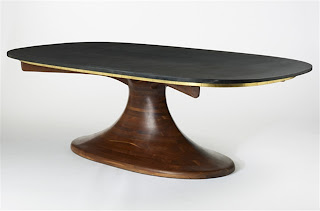Designer Spotlight: Phillip Lloyd Powell (1919-2008)
Phillip Powell, Fireplace (1956 – 1958), walnut, Rago Auctions: Saturday, April 12, 2008, A 20th Century Modern Weekend (Lot 140).
Born in 1919 in Germantown, Pennsylvania, Powell attended Drexel University where he studied engineering. However, he decided to abandon his career path to focus on his favorite activity: woodworking. After serving his country during World War II, he settled in New Hope in 1947. New Hope, located in Bucks County, was known then as it is now as a community for artists. Powell had opened up his own shop selling refurbished antiques and also the work of his contemporaries. While running the shop, Powell continued to actively make his own furniture. An able craftsman, he even built his own home. Eventually, in 1951, Powell opened a showroom where he sold his handcrafted furniture; all of the pieces were hand-carved in his New Hope studio.
Fortuitously, it was in the early 1950s that Evan’s wandered into this shop and impressed by the selection and quality of the work on display that he asked to exhibit his work there as well. Evans, considerably younger than Powell, already had a burgeoning career of his own. This began a fruitful collaboration which resulted in the two men becoming business partners and artistic collaborators as they opened another shop together and worked side by side in a shared studio space. Powell’s beautiful carved woods complemented Evans’ hard steel surfaces. One of their most prolific joint efforts was the Upper West Side apartment of the actress Shari Lewis. The duo created over thirty signature pieces of furniture for her.
Powell’s material of choice was wood. Beautifully carved walnut consoles and sideboards show the craftsman’s hand in their imperfect curves. He once told an interviewer (Edith Skiba Lamonic, “Behind the Eye: Phillip Lloyd Powell” Artsbridge Online, Dec 6, 2005 http://www.artsbridgeonline.com/behindtheeye/powell.shtml), that his favorite tool was a spoke shave, a side-handled plane, which allowed for such a silhouette. Powell, who loved to travel, often included found objects in his furniture. During his lifetime he produced no more than one thousand pieces of furniture. His clients could always rely on him to produce highly unique pieces for them in the most beautiful woods which had a sculpture-like quality to them. But his works weren’t show pieces, they were well-made and functional. He carefully thought out each design, always sketching it first. In that same interview he explained that his furniture was held in place by the use of splines, rabbit joints, dovetails and butterfly inserts. He also coated his pieces with oil to bring out the color and grain of the wood.
Phillip Powell, Dining table (ca. 1965), slate, laminated walnut, gilt wood, Wright: Sunday, May 18, 2008, Important Design: Session 1 (Lot 366).
Calendar
| M | T | W | T | F | S | S |
|---|---|---|---|---|---|---|
| 1 | 2 | 3 | 4 | 5 | 6 | 7 |
| 8 | 9 | 10 | 11 | 12 | 13 | 14 |
| 15 | 16 | 17 | 18 | 19 | 20 | 21 |
| 22 | 23 | 24 | 25 | 26 | 27 | 28 |
| 29 | 30 | 31 | ||||
Archives
- June 2018
- March 2018
- December 2016
- January 2016
- November 2015
- September 2015
- August 2015
- June 2015
- March 2015
- February 2015
- December 2014
- November 2014
- October 2014
- May 2014
- April 2014
- January 2014
- December 2013
- November 2013
- October 2013
- September 2013
- June 2013
- May 2013
- April 2013
- March 2013
- February 2013
- December 2012
- November 2012
- October 2012
- September 2012
- August 2012
- July 2012
- June 2012
- May 2012
- April 2012
- March 2012
- February 2012
- January 2012
- December 2011
- November 2011
- October 2011
- September 2011
- July 2011
- June 2011
- May 2011
- April 2011
- March 2011
- February 2011
- January 2011
- December 2010
- November 2010
- October 2010
- September 2010
- July 2010
- June 2010
- May 2010
- April 2010
- March 2010
- February 2010
- January 2010
- December 2009
- November 2009
- October 2009
- September 2009
- August 2009
- July 2009
- June 2009
Categories
- 20th c. design
- Architecture
- Art Deco
- Art Jewelry Forum
- Art Nouveau
- Auction
- Bard Graduate Center
- Blog update
- Brooklyn Metal Works
- Brooklyn Museum
- Ceramics
- Christie's
- Contemporary Art
- Contemporary Design
- Cooper-Hewitt
- Costume Institute
- Decorative Arts Calendar
- Design Exhibition Review
- Designer Spotlight
- Exhibition review
- Extraordinary lives
- Fashion
- Fashion exhibition review
- Fashion photography
- Film
- Fresh Talent
- Furniture
- Gallery Spotlight
- Glass
- ICP NY
- Italian Design
- Jewelry
- Lecture
- MCNY
- Metropolitan Museum of Art
- MoMA
- Museum at F.I.T
- Museum of Arts and Design
- Neue Galerie NY
- On the Market
- Paper Art
- Paris
- Phillips de Pury & Company
- Pinakothek de Moderne
- Platforma
- Public Art
- Rago
- Recently Published Articles
- Russian Decorative Arts
- R|R Gallery
- Sculpture
- Sotheby's
- Television
- Textiles
- Travel
- Uncategorized
- Upcoming Events
- Vintage Clothing
- Wiener Werkstatte
- Wright


Leave a Reply